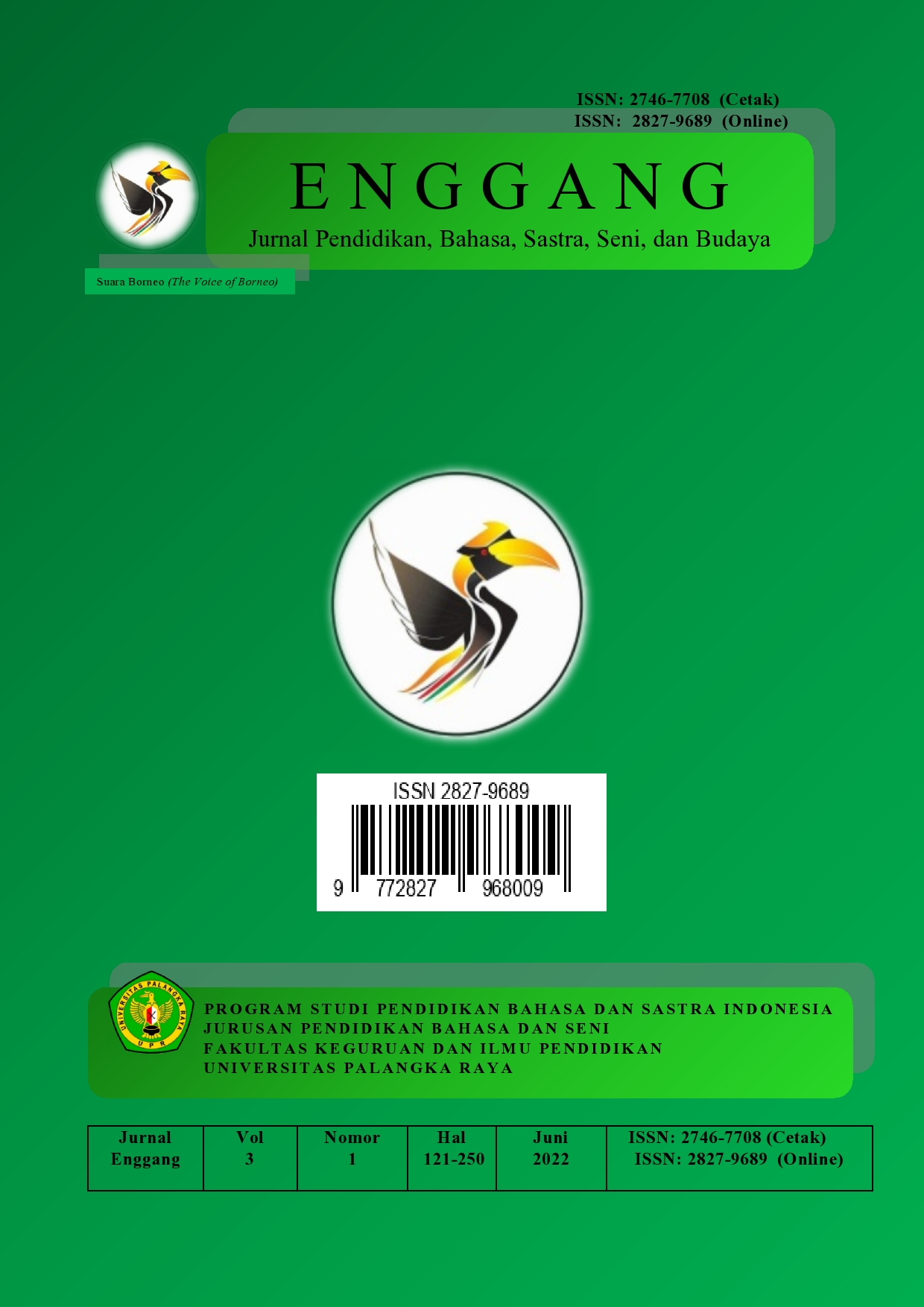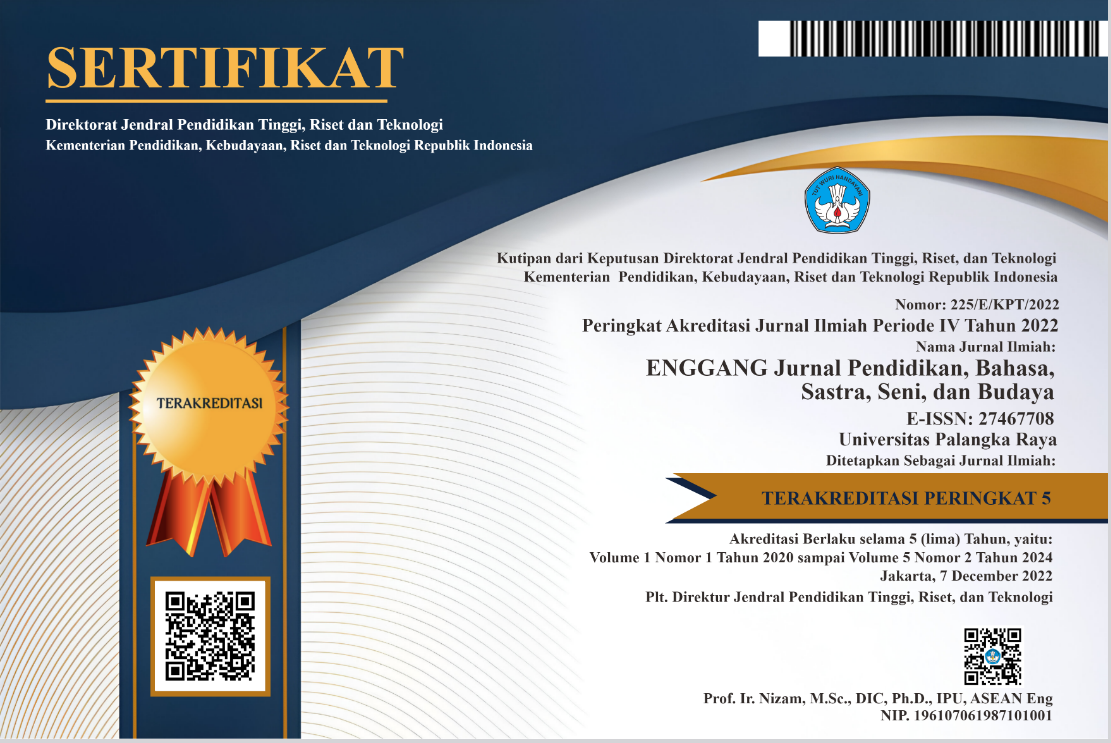Inferioritas dan Superioritas Tokoh dalam Novel Hello Salma Karya Erisca Febriani
Kajian Psikologi Individual Alfred Adler
DOI:
https://doi.org/10.37304/enggang.v5i1.10388Keywords:
Inferiority and Superiority, Alfred Adler's Individual Psychology, NovelAbstract
Inferiority and superiority are part of Alfred Adler's concept of individual psychology. The purpose of this study is to understand more deeply about the forms of inferiority in the aspects of feeling (1) insecure, (2) shyness, (3) withdrawing from the environment (withdrawal), forms of superiority in the aspects of (1) defense ego, (2) confident, (3) patient, (4) idealistic, in the novel Hello Salma by Ersica Febriani. The method used is descriptive qualitative. The data were obtained in the form of facts and then analyzed using the Psychology of Literature approach. Collection techniques namely reading notes, literature study, and corpus. Analysis techniques through the preparation stage, collecting theory, selecting, analyzing, drawing conclusions, and preparing reports. The results of the study show the inferiority of the characters in terms of feelings: (1) insecure including pessimism, lack of confidence experienced by Nathan and Salma. (2) Shyness (shyness), a feeling of anxiety about other people's views of her owned by Rebecca, as well as Salma's silent and awkward attitude. (3) Withdrawing from the environment (withdrawal), feeling uncomfortable, insecure in a social environment, often seen alone, was found in Rebcca. Forms of superiority aspect: (1) Ego defense, maintaining self-image as well as trying to accept Nathan's situation. (2) Confidence, belief in one's own abilities, having a strong drive for achievement that Rebecca feels. (3) Patience, keeping the soul from complaining, patiently accepting fate, not giving up easily that Salma encountered. (4) Idealistic, the idea that becomes the principle of life in accordance with the foundation that is considered perfect by the character Salma.
Downloads
References
Adler, A. (1917). Study of organ inferiority and its psychical compensation. Nervous and Mental Disease Publishing.
Adler, A. (1997). Understanding life: An introduction to the psychology of Alfred Adler. One World Oxford.
Ahyar, J. (2019). Apa itu sastra: Jenis-jenis karya sastra dan bagaimanakah cara menulis dan mengapresiasi sastra. Deepublish.
Al-Jauziyah, I. A. (2010). Indahnya sabar: Bekal sabar agar tak pernah habis. Maghfrah Utama.
Al-Mighwar, M. (2006). Psikologi remaja. CV. Pustaka Setia.
Alwisol. (2022). Psikologi kepribadian. UMM Press.
Aminuddin. (2012). Apresiasi sastra. Sinar Baru Algesindo.
Dwi, S. (2016). Pengantar kajian sastra. Center for Academic Publishing Service.
Endraswara, S. (2013). Metode penelitian psikologi sastra. CAPS (Center For Academic Publishing Service).
Fananie, Z. (2007). Telaah sastra. Muhammadiyah University Press.
Feist, J., & Feist, G. J. (2008). Theories of personality (6th ed.). Pustaka Pelajar.
Feist, J., & Feist, G. J. (2010). Teori kepribadian (7th ed.). Penerbit Salemba Humanika.
Ginting, S. M. B., Misnawati, M., Perdana, I., & Handayani, P. (2022, May). Obsesi tokoh dalam novel Guru Aini karya Andrea Hirata serta relevansinya dalam pembelajaran sastra di SMA (Tinjauan psikologi sastra). In Prosiding Seminar Nasional Pendidikan, Bahasa, Sastra, Seni, dan Budaya (Vol. 1, No. 1, pp. 13-26).
Gunarsah. (2008). Psikologi perkembangan anak dan remaja. PT Gunung Mulia.
Hakim, T. (2005). Mengatasi rasa tidak percaya diri. Puspa Swara.
Maslow, A. H. (1942). The dynamics of psychological security-insecurity. Journal of Personality, 10(4), 331–344. https://doi.org/10.1111/j.1467
Minderop, A. (2011). Psikologi sastra: Karya sastra, metode, teori, dan contoh kasus. Yayasan Pustaka Obor Indonesia.
Misnawati, M. (2023). Melintasi batas-batas bahasa melalui diplomasi sastra dan budaya: Crossing language boundaries through literary and cultural diplomacy. Pedagogik: Jurnal Pendidikan, 18(2), 185-193.
Naisaban, L. (2009). Para psikolog terkemuka dunia. Grasindo.
Nurgiyantoro, B. (2018). Teori pengkajian fiksi. Gadjah Mada.
Ratna, N. K. (2013). Teori, metode, dan teknik penelitian sastra. Pustaka Belajar.
Saleh, A. R., & Wahab, M. A. (2021). Psikologi: Suatu pengantar dalam perspektif Islam. Kencana Prenada Media Group.
Sariban. (2009). Teori dan penerapan penelitian sastra. Lentera Cendikia.
Semium, Y. (2013). Teori-teori kepribadian psikoanalitik kontemporer. Kanisius.
Suantoko. (2019). Kajian sosiologi sastra-objektif karya sastra sebagai dokumen sosial dalam trilogi cerpen Penembak Misterius. Jurnal Edukasi Khatulistiwa, 2(2), 13-26.
Sugihastuti. (2007). Teori apresiasi sastra. Pustaka Pelajar.
Suryabrata, S. (2016). Psikologi kepribadian. Rajawali Pers.
Tarigan, H. G. (2009). Prinsip-prinsip dasar sastra. Penerbit Angkasa Bandung.
Teeuw, A. (2003). Sastra dan ilmu sastra. Dunia Pustaka Jaya.
Wellek, R., & Warren, A. (1989). Teori kesusastraan. Gramedia Pustaka Utama.
Wicaksono, A. (2014). Pengkajian prosa fiksi. Garudhawaca.
Yanuarsih, S., et al. (2022). Realitas sosial budaya masyarakat Jawa dalam novel Gadis Pantai karya Pramoedya Ananta Toer. Piktorial, 1(4), 35-44.












